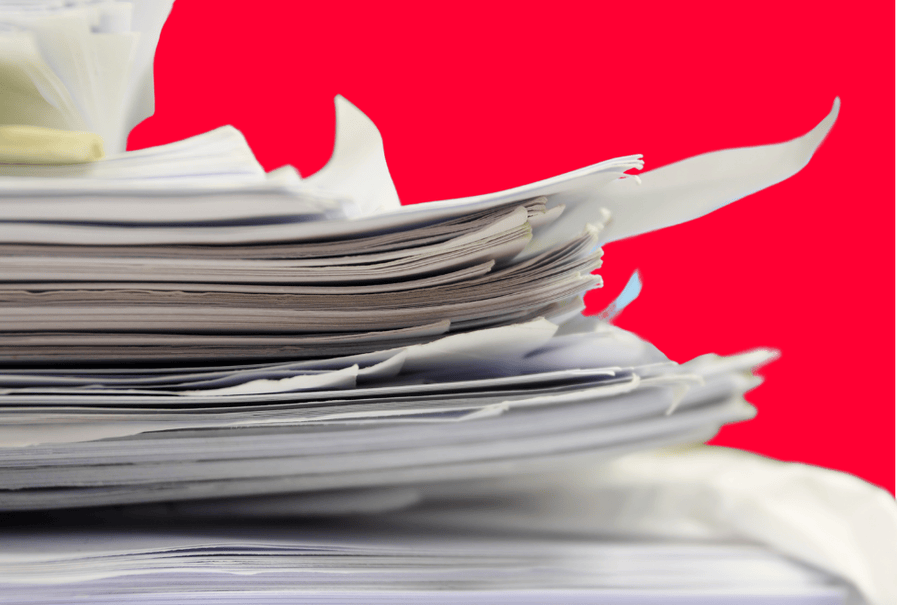
Imagine this: every day, millions of sheets of paper are printed, copied, and filed, piling up in offices, homes, and storage facilities across the world. But just how much paper are we using daily?
The world produces 400 million tons of paper every year. According to the U.S. Environmental Protection Agency, printing and writing papers typically found in a school or office environment — think such as copier paper, computer printouts, and notepads — comprise the largest category of paper product consumption and landfill waste.
This is an alarming figure considering the advanced technology of today’s world that is specifically designed to help offices go paperless. What does that mean for businesses trying to manage it all? In this blog, we’ll explore the staggering volume of paper consumed in a single day and how it impacts your organization’s efficiency and sustainability.
Paper Consumption in the United States
Paper Consumption Growth
While historical trends showed significant growth in U.S. paper consumption, recent trends have stabilized or declined slightly with the rise of digital alternatives. As of the 2010s, paper consumption in the U.S. peaked, but has been slowly decreasing in recent years due to environmental awareness and digital shifts. It’s currently estimated around 70-80 million tons per year, down from earlier highs of over 90 million tons.
Per Capita Consumption
The U.S. still consumes significantly more paper per capita than many other regions. While exact numbers vary, the average American uses approximately 700 pounds of paper annually. This remains to be substantially more than the average person in Asia. Recent data shows Asia’s per capita consumption being roughly half of that in the U.S., although the gap is closing as developing nations industrialize.
Global Paper Usage Share
With less than 5% of the world’s population, the U.S. is still responsible for about 20% of the world’s paper consumption. Yet, this is lower than the previous 30% share, due to increased consumption in other parts of the world like Asia and Europe.
Environmental Impact
The U.S. still uses an estimated 68-70 million trees annually to produce paper and paper products. However, efforts to increase paper recycling and sustainable forestry practices have helped mitigate some of the environmental impacts associated with paper production.
Paper Consumption in the Office
Did you know that the average office worker uses a ton of paper each year? In fact, a lot of it ends up in the trash by the end of the day! From forms that quickly go out-of-date to overflowing filing cabinets, paper can take up space, time, and money. Plus, relying on paper records can put businesses at risk if those files get damaged. Let’s take a closer look at some surprising facts about paper use in the office and why cutting back can make a big difference.
- The average office worker uses 10,000 sheets of copy paper each year.
- By the end of the day, 45% of paper printed in offices ends up in the trash.
- S corporations spend more than $120 billion a year on printed forms, most of which outdate themselves within three months’ time.
- A typical employee spends 30-40% of their time looking for information kept in filing cabinets.
- Each four-drawer file cabinet holds an average of 10,000 to 12,000 documents, taking up to nine square feet of floor space and costing $1,500 per year.
- More than 70% of businesses would fail within three weeks if they suffered a catastrophic loss of paper-based records due to fire or flood.
- The average business’ paper consumption grows by 22% per year. By these numbers, we can estimate that, in 3.3 years, their paper consumption will double.
Residential Paper Consumption
Residential paper consumption in the U.S. is estimated to be around 30-40 million tons per year. This includes paper products used in households such as newspapers, magazines, office paper, packaging, and tissue products. While these make up a large portion of the overall paper consumption, residential use has declined in recent years. More people are shifting to digital media and online shopping, which reduces the need for printed materials and packaging.
Why Go Paperless
Helping the Environment
Making paper uses trees, water, and energy, which can harm forests, pollute rivers, and release gasses that warm the planet. By using less paper, we help protect forests, keep rivers clean, and reduce pollution.
Saving Resources
Paper takes a lot of water and energy to make. Using less means we’re saving these valuable resources, which helps keep our planet healthy.
Creating Less Waste
When paper piles up in landfills, it creates pollution as it breaks down. Using less paper means we’re keeping landfills cleaner and cutting down on waste.
Saving Money
Using less paper can save businesses and people money on supplies, storage, and printing. Going digital can be a cheaper and easier way to keep track of important information.
Going Digital
Using less paper encourages us to go digital, which can make work faster, more organized, and easier to share—especially in business.
How Much Does Going Paperless Cost?
When thinking about going paperless, you might wonder what it will cost. Scanning documents usually costs 7-12 cents per page, but a few things can make the price go up or down.
Document Prep
If your files have lots of staples, clips, or need special sorting, it can cost a bit more since extra work is needed to get them ready to scan.
Number of Documents
The more pages you need scanned, the lower the cost per page tends to be. Larger jobs can be more affordable because setup costs are spread out over more pages.
How You Want to Search
Once scanned, it’s helpful to search your files for things like names or ID numbers. But, if you need more detailed search options, like multiple criteria, it can take extra time to set up, which can add to the cost.
Get Free, No-hassle Quotes on Scanning Services
Switching to a paperless system may sound like a big change, but Record Nations can help make it easy and affordable. From secure document scanning to digital storage solutions, Record Nations connects you with trusted providers who can handle your records efficiently and safely. By going digital, you’ll save space, reduce paper use, and help the environment — all while keeping your important files organized and accessible. Let Record Nations guide you toward a paper-free future that’s simple, secure, and sustainable.
Fill out the form, use our live chat, or give us a call at (866) 385-3706. Within minutes of receiving your request, you will have free quotes from experts in your area who can help you.












